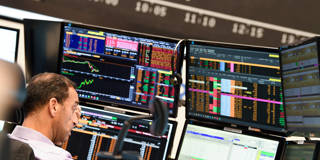Rising inflation and declining growth are more likely to be a part of the global economy’s upcoming journey than features of its destination. But how policymakers navigate this journey will have major implications for longer-term economic well-being, social cohesion, and financial stability.
CAMBRIDGE – A stream of recent data suggests that the global economy is showing signs of stagflation, that odd 1970s-style mixture of rising inflation and declining growth. Those who have noticed it – and there are still too few of them – fall into two broad camps. Some see the phenomenon as temporary, and quickly reversible. Others fear that it will lead to a renewed period of unsatisfactory growth, but this time with unsettlingly high inflation.
But a third scenario, which draws on both of these views, may well be the most plausible. Stagflationary winds are more likely to be a part of the global economy’s upcoming journey than a feature of its destination. But how policymakers navigate this journey will have major implications for longer-term economic well-being, social cohesion, and financial stability.
The much-needed global economic recovery has recently been losing steam as growth in its two major locomotives, China and the United States, has undershot consensus expectations. The more contagious Delta variant of the coronavirus has dampened spending in some sectors, such as leisure and transportation, while hampering production and shipments in others, particularly manufacturing. Labor shortages are becoming more widespread in a growing number of advanced economies. Add to that a shipping-container shortage and the ongoing reordering of supply chains, and it should come as no surprise that the headwinds to a strong and sustainable global recovery are being accompanied by higher and more persistent inflation.

CAMBRIDGE – A stream of recent data suggests that the global economy is showing signs of stagflation, that odd 1970s-style mixture of rising inflation and declining growth. Those who have noticed it – and there are still too few of them – fall into two broad camps. Some see the phenomenon as temporary, and quickly reversible. Others fear that it will lead to a renewed period of unsatisfactory growth, but this time with unsettlingly high inflation.
But a third scenario, which draws on both of these views, may well be the most plausible. Stagflationary winds are more likely to be a part of the global economy’s upcoming journey than a feature of its destination. But how policymakers navigate this journey will have major implications for longer-term economic well-being, social cohesion, and financial stability.
The much-needed global economic recovery has recently been losing steam as growth in its two major locomotives, China and the United States, has undershot consensus expectations. The more contagious Delta variant of the coronavirus has dampened spending in some sectors, such as leisure and transportation, while hampering production and shipments in others, particularly manufacturing. Labor shortages are becoming more widespread in a growing number of advanced economies. Add to that a shipping-container shortage and the ongoing reordering of supply chains, and it should come as no surprise that the headwinds to a strong and sustainable global recovery are being accompanied by higher and more persistent inflation.